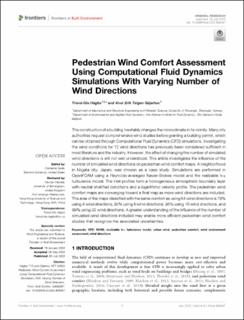| dc.contributor.author | Hågbo, Trond-Ola | |
| dc.contributor.author | Giljarhus, Knut Erik Teigen | |
| dc.date.accessioned | 2023-02-20T11:47:04Z | |
| dc.date.available | 2023-02-20T11:47:04Z | |
| dc.date.created | 2022-07-18T22:12:46Z | |
| dc.date.issued | 2022-07 | |
| dc.identifier.citation | Hågbo, T-O., Giljarhus, K.E.T. (2022) Pedestrian Wind Comfort Assessment Using Computational Fluid Dynamics Simulations With Varying Number of Wind Directions. Frontiers in Built Environment, 8 | en_US |
| dc.identifier.issn | 2297-3362 | |
| dc.identifier.uri | https://hdl.handle.net/11250/3052318 | |
| dc.description.abstract | The construction of a building inevitably changes the microclimate in its vicinity. Many city authorities request comprehensive wind studies before granting a building permit, which can be obtained through Computational Fluid Dynamics (CFD) simulations. Investigating the wind conditions for 12 wind directions has previously been considered sufficient in most literature and the industry. However, the effect of changing the number of simulated wind directions is still not well understood. This article investigates the influence of the number of simulated wind directions on pedestrian wind comfort maps. A neighborhood in Niigata city, Japan, was chosen as a case study. Simulations are performed in OpenFOAM using a Reynolds-averaged Navier-Stokes model and the realizable k-ϵ turbulence model. The inlet profiles form a homogeneous atmospheric boundary layer with neutral stratified conditions and a logarithmic velocity profile. The pedestrian wind comfort maps are converging toward a final map as more wind directions are included. The area of the maps classified with the same comfort as using 64 wind directions is 79% using 4 wind directions, 92% using 8 wind directions, 96% using 16 wind directions, and 99% using 32 wind directions. A greater understanding of the influence of the number of simulated wind directions included may enable more efficient pedestrian wind comfort studies that recognize the associated uncertainties. | en_US |
| dc.language.iso | eng | en_US |
| dc.publisher | Frontiers Media S.A | en_US |
| dc.relation.uri | https://www.frontiersin.org/articles/10.3389/fbuil.2022.858067/full | |
| dc.rights | Navngivelse 4.0 Internasjonal | * |
| dc.rights.uri | http://creativecommons.org/licenses/by/4.0/deed.no | * |
| dc.subject | konstruksjoner og materialer | en_US |
| dc.subject | vindstudier | en_US |
| dc.subject | CFD | en_US |
| dc.title | Pedestrian Wind Comfort Assessment Using Computational Fluid Dynamics Simulations With Varying Number of Wind Directions | en_US |
| dc.type | Peer reviewed | en_US |
| dc.type | Journal article | en_US |
| dc.description.version | publishedVersion | en_US |
| dc.rights.holder | © 2022 The Authors. | en_US |
| dc.source.volume | 8 | en_US |
| dc.source.journal | Frontiers in Built Environment | en_US |
| dc.identifier.doi | 10.3389/fbuil.2022.858067 | |
| dc.identifier.cristin | 2038706 | |
| dc.relation.project | Norges forskningsråd: 280458 | en_US |
| cristin.ispublished | true | |
| cristin.fulltext | original | |
| cristin.qualitycode | 1 | |

